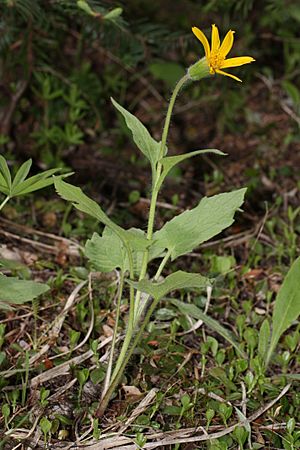Heartleaf arnica facts for kids
Quick facts for kids Heartleaf arnica |
|
|---|---|
 |
|
| Wenatchee Mountains, Washington | |
| Scientific classification | |
| Genus: |
Arnica
|
| Species: |
cordifolia
|
| Synonyms | |
|
Synonymy
Arnica abortiva Greene
Arnica andersonii Piper Arnica austinae Rydb. Arnica chionophila Greene Arnica evermannii Greene Arnica hardinae H.St.John Arnica humilis Rydb. Arnica macrophylla Nutt. Arnica microphylla Walp. Arnica paniculata A.Nelson Arnica parviflora Greene 1901 not A.Gray 1868 Arnica pumila Rydb. Arnica subcordata Greene Arnica whitneyi Fernald |
|
Arnica cordifolia, also known as heartleaf arnica, is a beautiful wild flower. It belongs to the sunflower family. You can find it growing across western North America. It stretches from Alaska all the way down to California and New Mexico. It even grows as far east as Ontario and Michigan. This plant loves many different places. It grows in pine forests and wet mountain meadows. You can find it from sea level up to very high mountains, sometimes over 12,000 feet! But it's most common between 4,000 and 11,000 feet high.
Contents
What Does Heartleaf Arnica Look Like?
This plant is a perennial herb. This means it lives for many years. It grows from an underground stem called a rhizome. The rhizome helps the plant spread. It sends up one or more straight stems. These stems can grow up to about half a meter tall.
Leaves and Flowers
The plant has two to four pairs of leaves on its stem. Each leaf grows on a long stalk called a petiole. The leaves are shaped like a heart or an arrowhead. They have small teeth along their edges.
At the top of the stem, you'll see one or more flower heads. These look like small daisy flowers. Each flower head is surrounded by special leaf-like parts called phyllaries. These phyllaries are covered in white hairs. Sometimes, they also have sticky resin glands.
The center of each flower head has many small, golden yellow disc florets. Around the edge, there's a fringe of bright golden ray florets. These ray florets can be almost 3 centimeters long.
Seeds and Life Cycle
After the flowers bloom, the plant produces fruit. The fruit is a hairy achene, which is a type of dry fruit. It can be up to a centimeter long. It has a fluffy, off-white top called a pappus. This pappus helps the seeds float away on the wind. This is how the plant spreads its seeds.
A single heartleaf arnica plant can live for up to twelve years. It's very tough! If there's a wildfire, the plant can survive. It simply grows new shoots from its long, thin rhizome underground.
How to Tell it Apart
Heartleaf arnica can sometimes be confused with another similar plant called Arnica latifolia. But you can tell them apart by looking at their leaves. The leaves of Arnica cordifolia are larger and clearly heart-shaped.
Traditional Uses
People have traditionally used the dried leaves of heartleaf arnica. They can be made into a poultice. A poultice is a soft, moist mass of material, often plant-based, applied to the body. They can also be made into a tincture. A tincture is a medicine made by dissolving a substance in alcohol. These preparations were used to help treat strains and bruises.

